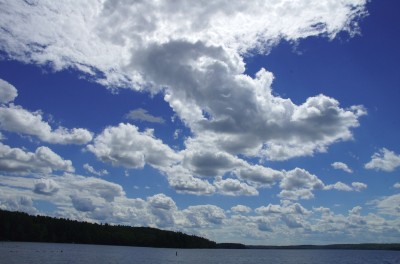Raw Power
After having a Nikon D70 for two years, I’ve finally taken a few tentative steps toward using the so-called Raw format. I’ve been reading a book by Rob Sheppard.
I took my first Raw picture of some clouds the other day. At the time I was thinking that this was a challenging subject in terms of dynamic range that might benefit from being shot in Raw.

Click for a larger version.
I could stare at clouds for hours (see “Deep Thoughts 2”), especially backlit clouds, but I have never been able to capture the luminous effect. This pic begins to do it. Although I was very careful with the exposure, I otherwise didn’t edit this picture. I’m not sure how this shot looks on your monitor, but the clouds just seem to pop more than in any other shot I’ve taken. I don’t know whether this is because it was shot in Raw or not, though. Anyway, baby steps.


Comments
Hm, if you didn't otherwise edit this photo, I'm not sure what benefit you would get from shooting in RAW unless the default settings of your RAW converter were better suited for processing this image than whatever you have your camera set to do when it shoots JPGs. The benefits of RAW have more to do with the latitude you get when post-processing the image, particularly with regards to keeping the image in 16-bit while you make adjustments, as well as being able to adjust white balance, exposure, etc.
I agree with you that this image really pops. But I'd have to credit it to your careful choice of exposure, rather than to using RAW.
I think, if you enjoy post-processing, that you'll really enjoy shooting in RAW. If you hate post-processing, it may not be worth it. :) Personally I find it to be worth the extra step for those times when I do want to make adjustments and wouldn't want to be fighting with the set parameters of a JPG image.
Posted by seadragon on August 21, 2006 at 11:33 PM
Seadragon, You're right, I got no benefit from using Raw. I was kind of thinking out loud sharing my surprise about the results of no post-processing vs. my usual JPEG workflow of contrast tweaking with a simple S curve and an unsharp mask action. I think you're saying the default Raw conversion is better than my hand tweaking. I totally agree and that hurts. :-) I'd like to find out what the converter settings are. (I previewed the image in GraphicConverter and just did a Save As.) If I could match that look by adjusting the Camera Raw plugin I would learn a lot, I think. I took a few other shots on the trip and they all look like that in GraphicConverter, kind of the way slides do through a loupe on a lightbox - saturated and contrasty in a pleasing way. But you're right; it's not the Raw format itself. The way things seem, I'd be doing *less* post-processing with Raw since I like the default results better than hand-tweaking. :-)
Posted by Tony on August 22, 2006 at 8:57 AM
One quick thing you might want to check to see why the RAW images might look different than your previous JPGs, is what your JPG settings are on your camera. You might think you have them set to "nothing" (i.e., "0"), but that's usually misleading. I use Canon, so I don't know the settings on the D70, but my guess is that you have settings for Saturation, Contrast, and Sharpening. Usually setting them to the lowest end of the scale (maybe -2 or -1, depending on the scale) means that it only processes them the minimum levels, setting them in the middle sets them to be whatever Nikon considers a good default (these are usually kind of punchy, since that's what people usually like), and setting them at the high end (1 or 2) gives you more heavily processed images. If you're doing your own processing after shooting, even if you're shooting JPG, you might want to have all the settings as low as possible in case you didn't want that much contrast / saturation / sharpening. You can always add more, but it's much harder to remove (e.g., you really can't remove sharpening, and you can't decrease contrast very much without revealing noise in the darker areas, etc.).
Of course, if you're shooting in RAW it doesn't matter what those are set to because no in-camera processing is being done to your image - that's the point of RAW. :) The only settings are whatever you choose to set in your RAW converter (or accept the defaults of the converter).
Anyway, hope you have fun playing around with this! It's funny that as you're exploring RAW, I'm wondering if maybe I spend too much time post-processing and should go back to JPG...
Posted by seadragon on August 22, 2006 at 9:46 PM